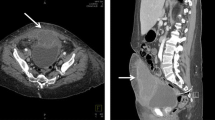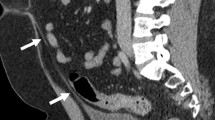Abstract
Congenital urachal anomalies are present in less than 2 % of the general pediatric population. While traditionally thought of as pre-malignant, their clinical significance particularly in the asymptomatic patient has been questioned. The presence of a urachal anomaly in childhood does not appear to confer an increased risk of urachal cancer in adulthood. These remnants are classified based upon their anatomic location and communication with either the umbilicus or bladder and may present with a variety of symptoms. When clinical signs and symptoms suggest the presence of an urachal anomaly, ultrasonography is the most appropriate initial diagnostic imaging test. Observation with or without follow-up imaging is an acceptable initial step in management as these often regress without surgical intervention particularly in asymptomatic patients. When infectious symptoms are present, a course of antibiotics may be recommended prior to surgery to reduce the chance of postoperative wound infection.
Similar content being viewed by others
References
Papers of particular interest, published recently, have been highlighted as: • Of importance •• Of major importance
Nix JT, Menville JG, Albert M, Wendt DL. Congenital patent urachus. J Urol. 1958;79:264–73.
Blichert-Toft M, Nielsen OV. Congenital patient urachus and acquired variants. Diagnosis and treatment. Review of the literature and report of five cases. Acta Chir Scand. 1971;137:807–14.
Razvi S, Murphy R, Shlasko E, Cunningham-Rundles C. Delayed separation of the umbilical cord attributable to urachal anomalies. Pediatrics. 2001;108:493–4.
Begg RC. The Urachus: its anatomy, histology and development. J Anat. 1930;64:170–83.
Mahoney P, Ennis D. Congenital patent urachus. N Engl J Med. 1936;215:193–202.
Gleason JM, Bowlin PR, Bagli DJ, Lorenzo AJ, Hassouna T, Koyle MA, et al. A comprehensive review of pediatric urachal anomalies and predictive analysis for adult urachal adenocarcinoma. J Urol. 2015;193:632–6. First and only study that attempts to correlate the incidence of congenital urachal anomalies in children and the development of urachal adenocarcinoma in adults.
Ueno T, Hashimoto H, Yokoyama H, Ito M, Kouda K, Kanamaru H. Urachal anomalies: ultrasonography and management. J Pediatr Surg. 2003;38:1203–7.
Fox JA, McGee SM, Routh JC, Granberg CF, Ashley RA, Hutcheson JC, et al. Vesicoureteral reflux in children with urachal anomalies. J Pediatr Urol. 2011;7:632–5. Study showing the highest recorded association between urachal anomalies and vesicoureteral reflux which also draws into question the clinical significance such asymptomatic vesicoureteral reflux may play.
Holten I, Lomas F, Mouratidis B, Malecky G, Simpson E. The ultrasonic diagnosis of urachal anomalies. Australas Radiol. 1996;40:2–5.
Mesrobian HGO, Zacharias A, Balcom AH, Cohen RD. Ten years of experience with isolated urachal anomalies in children. J Urol. 1997;158:1316–8.
Cilento BG, Bauer SB, Retik AB, Peters CA, Atala A. Urachal anomalies: defining the best diagnostic modality. Urology. 1998;52:120–2.
Yiee JH, Garcia N, Baker LA, Barber R, Snodgrass WT, Wilcox DT. A diagnostic algorithm for urachal anomalies. J Pediatr Urol. 2007;3:500–4.
Huang C-S, Luo C-C, Chao H-C, Chen H-M, Chu S-M. Urachal anomalies in children: experience at one institution. Chang Gung Med J. 2003;26:412–6.
Choi YJ, Kim JM, Ahn SY, Oh J-TT, Han SW, Lee JS. Urachal anomalies in children: a single center experience. Yonsei Med J. 2006;47:782–6.
Rich RH, Hardy BE, Filler RM. Surgery for anomalies of the urachus. J Pediatr Surg. 1983;18:370–2.
Naiditch JA, Radhakrishnan J, Chin AC. Current diagnosis and management of urachal remnants. J Pediatr Surg. 2013;48:2148–52. Elsevier Inc.
Nogueras-Ocaña M, Rodríguez-Belmonte R, Uberos-Fernández J, Jiménez-Pacheco A, Merino-Salas S, Zuluaga-Gómez A. Urachal anomalies in children: surgical or conservative treatment? J Pediatr Urol. 2014;10:522–6.
Ashley RA, Inman BA, Routh JC, Rohlinger AL, Husmann DA, Kramer SA. Urachal anomalies: a longitudinal study of urachal remnants in children and adults. J Urol. 2007;178:1615–8.
Galati V, Donovan B, Ramji F, Campbell J, Kropp BP, Frimberger D. Management of urachal remnants in early childhood. J Urol. 2008;180:1824–7.
Frimberger DC, Kropp BP. Bladder anomalies in children. Tenth Edit. Campbell-Walsh Urol. Philadelphia: Elsevier Inc.; 1995.
Steck WD, Helwig EB. Umbilical granulomas, pilonidal disease, and the urachus. Surg Gynecol Obstet. 1965;120:1043–57.
Berman SM, Tolia BM, Laor E, Reid RE, Schweizerhof SP, Freed SZ. Urachal remnants in adults. Urology. 1988;31:17–21.
Yu JS, Kim KW, Lee HJ, Lee YJ, Yoon CS, Kim MJ. Urachal remnant diseases: spectrum of CT and US findings. Radiographics. 2001;21:451–61.
Blichert-Toft M, Nielsen OV. Diseases of the urachus simulating intra-abdominal disorders. Am J Surg. 1971;122:123–8.
Metwalli ZA, Guillerman RP, Mehollin-Ray AR, Schlesinger AE. Imaging features of intravesical urachal cysts in children. Pediatr Radiol. 2013;43:978–82. First study to describe a previously unclassified form of urachal anomaly.
McCollum MO, Macneily AE, Blair GK. Surgical implications of urachal remnants: presentation and management. J Pediatr Surg. 2003;38:798–803.
Guarnaccia SP, Mullins TL, Sant GR. Infected urachal cysts. Urology. 1990;36:61–5.
MacNeily AE, Koleilat N, Kiruluta HG, Homsy YL. Urachal abscesses: protean manifestations, their recognition, and management. Urology. 1992;40:530–5.
Giuliani S, Vendryes C, Malhotra A, Shaul DB, Anselmo DM. Prune belly syndrome associated with cloacal anomaly, patent urachal remnant, and omphalocele in a female infant. J Pediatr Surg. 2010;45:e39–42.
Lane V. Congenital patent urachus associated with complete (hypospadiac( duplication of the urethra and solitary crossed renal ectopia. J Urol. 1982;127:990–1.
Herbst WP. Patent urachus. South Med J. 1937;30:711.
Schreck WR, Campbell WA. The relation of bladder outlet obstruction to urinary-umbilical fistula. J Urol. 1972;108:641–3.
Blichert-Toft M, Koch F, Nielsen OV. Anatomic variants of the urachus related to clinical appearance and surgical treatment of urachal lesions. Surg Gynecol Obstet. 1973;137:51–4.
Schneck FX. Commentary to “vesicoureteral reflux in children with urachal anomalies”. J Pediatr Urol. 2011;7:636.
Little DC, Shah SR, St Peter SD, Calkins CM, Murphy JP, Gatti JM, et al. Urachal anomalies in children: the vanishing relevance of the preoperative voiding cystourethrogram. J Pediatr Surg. 2005;40:1874–6.
Yohannes P, Bruno T, Pathan M, Baltaro R. Laparoscopic radical excision of urachal sinus. J Endourol. 2003;17:475–9.
Sheldon CA, Clayman RV, Gonzalez R, Williams RD, Fraley EE. Malignant urachal lesions. J Urol. 1984;131:1–8.
Cuda SP, Vanasupa BP, Sutherland RS. Nonoperative management of a patent urachus. Urology. 2005;66:1320.
Upadhyay V, Kukkady A. Urachal remnants: an enigma. Eur J Pediatr Surg. 2003;13:372–6.
Pinthus JH, Haddad R, Trachtenberg J, Holowaty E, Bowler J, Herzenberg AM, et al. Population based survival data on urachal tumors. J Urol. 2006;175:2042–7.
Lipskar AM, Glick RD, Rosen NG, Layliev J, Hong AR, Dolgin SE, et al. Nonoperative management of symptomatic urachal anomalies. J Pediatr Surg. 2010;45:1016–9. Elsevier Inc.
Copp HL, Wong IY, Krishnan C, Malhotra S, Kennedy WA. Clinical presentation and urachal remnant pathology: implications for treatment. J Urol. 2009;182:1921–4. Elsevier Inc.
Zieger B, Sokol B, Rohrschneider WK, Darge K, Tröger J. Sonomorphology and involution of the normal urachus in asymptomatic newborns. Pediatr Radiol. 1998;28:156–61.
Newman BM, Karp MP, Jewett TC, Cooney DR. Advances in the management of infected urachal cysts. J Pediatr Surg. 1986;21:1051–4.
Bertozzi M, Riccioni S, Appignani A. Laparoscopic treatment of symptomatic urachal remnants in children. J Endourol. 2014;28:1091–6.
Redmond HP, Ahmed SM, Watson RG, Hegarty J. Laparoscopic excision of a patent urachus. Surg Laparosc Endosc. 1994;4:384–5.
Bertozzi M, Nardi N, Prestipino M, Magrini E, Appignani A. Minimally invasive removal of urachal remnants in childhood. Pediatr Med Chir. 2009;31:265–8.
Pesce C, Costa L, Musi L, Campobasso P, Zimbardo L. Relevance of infection in children with urachal cysts. Eur Urol. 2000;38:457–60.
Compliance with Ethics Guidelines
Conflict of Interest
Hans Arora and Jeffrey Donohoe declare that they have no conflict of interest.
Human and Animal Rights and Informed Consent
This article does not contain any studies with human or animal subjects performed by any of the authors.
Author information
Authors and Affiliations
Corresponding author
Additional information
This article is part of the Topical Collection on Pediatric Bladder Dysfunction




